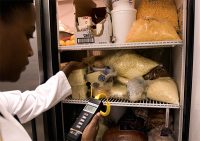Safety is a priority when handling food. Don’t think of it as a chore to appease the health inspector. Food storage and safe handling can prevent your customers from getting sick. Whether you’re a veteran of the industry or just starting out, reviewing these tips can improve your restaurant’s operations and keep your guests safe.
Remember FIFO
FIFO, first in first out, should become your mantra when using stock. This rule governs stock rotation and use. When you receive a delivery, place the new stock behind the existing stock. Doing so reduces waste as you won’t have goods stored past their expiration dates. Use the stock at the front to always make use of the oldest products first.

Train your employees to track the expiration dates on all the goods in storage. A sheet listing the expiration of new and existing products easily shows this information. Stress the importance of using goods before their best by date for optimal safety and quality.
Keep Storage Dry and Dark
Dark, dry storage areas maximize the storage time of foods. Whether it’s dry goods in pantry storage or cold products in a refrigerator or freezer, the ideal conditions are out of direct sunlight. This helps control the temperature and prevent the food from degrading. Products with vitamins A, D, K and E, which are fat-soluble, can also break down in sunlight.
The humidity levels should stay lower than 15% to help preserve product quality. Moisture-proof packaging and air conditioning can maintain the appropriate levels. Keep a hygrometer in your storage areas to verify the humidity levels remain consistent. To protect food from contaminants and vermin, place shelves so food is at least six inches from the floor and walls, and one foot from the ceiling.
Storage Temperatures Are Key
Depending on what you store, temperatures may range from freezing to 140° F. Maintain dry storage temperatures between 50° and 70° F. Freezers must keep food frozen solid with an internal temperature of 0° F at most. Keep temperatures between 32° and 40° F in refrigeration units to prevent bacterial growth. Hot storage must keep food at a minimum of 140° F.

These temperature ranges are critical to prevent food poisoning. Track temperatures and discard any food stored at the wrong temperature. Consider installing alarms tied to the thermometers in your storage units to alert your employees of critical temperature changes that could affect food safety and quality.
Store Based on Cooking Temperature
Did you know the temperature you must cook foods will determine which shelf you store them on in the refrigerator? The lower the finished temperature of cooked food, the higher a shelf you store it on. Ready-to-eat and cooked foods need to stay on the top shelf, wrapped tightly to prevent cross-contamination. Any ready-to-eat meats and cheeses go on the shelf below. Again, keep them tightly covered or wrapped.
Raw foods go on the bottom three shelves. The third shelf from the top should hold foods cooked to 145° F. including raw fish and shellfish. Below that shelf, keep raw pork, beef and veal. These include cuts and steaks but not ground meat. These have a cooked temperature of 155° F. The bottom shelf holds ground meat and whole eggs. These must cook to an internal temperature of 165° F.
Foods that need cooking thoroughly must stay in enclosed pans or on non-absorbent shelving. Use airtight containers where possible to store food. This protects the food from drying out, preserving its quality. Additionally, the food will stay free of contamination from other foods in the storage unit. This is especially important for refrigerated foods, which may still harbor liquids that can get onto other foods.
Label and Check Foods in Storage
While you should label unopened foods, it’s even more important to label opened foods. Use all foods before the type expires. For instance, summer sausage stays fresh for only three weeks after opening in the refrigerator, but it stays good up to three months unopened. If in doubt, throw the food out. It’s better to stay safe than sorry.
Prevent Cross Contamination During Cooking
During cooking, you can prevent contamination of fresh foods by raw foods through regular hygiene practices. All employees should thoroughly wash their hands with 110°-F water and soap. Despite hand washing, gloves must be worn at all times to protect consumers further.

When cooking, never use the same cutting boards for raw meats and ready-to-eat foods. Juice from undercooked meat could contaminate salad ingredients, sickening those who eat the salad. Also, use a cooking thermometer and always cook foods to the appropriate internal temperature based on the type of food. Reheat previously cooked dishes to an internal temperature of 165° F to stop bacteria growth.
When storing foods, place them in airtight containers that you can easily identify. This prevents things such as milk and cream from accidentally getting replaced with each other. It also ensures every item gets stored correctly. Correct labels on containers also help with preventing mix-ups.
Food Safety Starts With You
Food safety is critical to your restaurant’s operations. Improper storage can shut down your business from a food poisoning outbreak or a bad inspection from the local health inspector. Don’t let these happen to you. Follow these guidelines to ensure the food you store and serve remains safe and high-quality.



 While cities like Guelph, Ontario, are being dragged into the age of public disclosure, countries like Singapore have been training and using restaurant patrons as gumshoes for a decade to help public health types identify possible infractions through the use of cell phones (with nifty cameras).
While cities like Guelph, Ontario, are being dragged into the age of public disclosure, countries like Singapore have been training and using restaurant patrons as gumshoes for a decade to help public health types identify possible infractions through the use of cell phones (with nifty cameras).